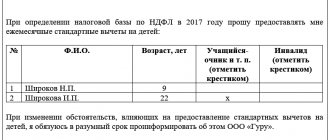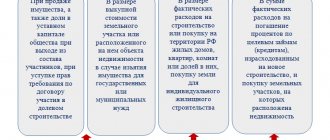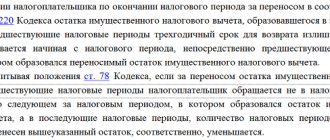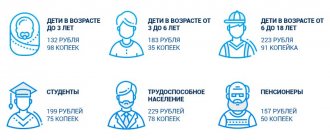Home / Family law / Children's rights
Back
Published: 08/13/2018
Reading time: 7 min
0
310
The tax deduction is compensation for the expenses incurred by parents and guardians of a disabled child in caring for him. The tax base for personal income tax is reduced by the amount of deductions provided to him, thereby increasing the amount of funds due to him personally.
- Documents confirming the right to apply a tax deduction
- How to write a statement correctly
- Determining the amount of the standard tax deduction for a disabled child Tax deduction for a child
- Additional tax deduction for a disabled child
- Tax deduction codes for disabled children
The child's natural parents, adoptive parents, guardians, trustees and foster parents have the right to receive a deduction.
Double tax deduction for disabled children
A tax deduction for a disabled minor is provided to both parents. However, there are situations when one of the parents can count on a double deduction from the taxes paid. This is possible if a disabled child is being raised by a single parent, or if one of the parents refused to receive tax benefits in favor of the other.
In order for one parent to refuse a tax deduction in favor of the other, he must himself be entitled to these benefits. That is, he must receive income that is taxed at a tax rate of 13%, and the annual value of which does not exceed 350 thousand.
If one parent refuses, the other can count on a deduction in the amount to which the first was entitled.
Amounts of tax deductions in the presence of a disabled child
There are certain features for the deduction for disabled children, the essence of which is that the amount of the standard deduction for a disabled child is summed up with the amount of the deduction that is provided for him, taking into account which of the children in the family he is.
A tax deduction for a disabled child under the age of 18 or a disabled child of group I or II who is a full-time student, graduate student, student under the age of 24 is provided regardless of the order of birth of such a child in the amount of:
- 12,000 rubles - to the parent, spouse of the parent, adoptive parent;
- 6,000 rubles - to a guardian, trustee, adoptive parent, spouse of an adoptive parent.
The above deduction amounts are summed up with the standard deduction amounts associated with the order of birth of a disabled child. The deduction amounts associated with the order of birth of the child are as follows:
- 1,400 rubles – for the first child;
- 1,400 rubles – for the second child;
- 3,000 rubles – for the third and subsequent children.
The above means that the deduction to a parent or adoptive parent for a disabled child born first or second will be 13,400 rubles (1,400 rubles + 12,000 rubles) per month, and for a disabled child born third or next - 15,000 rubles (3,000 rubles + 12,000 rubles).
The deduction is provided to both parents.
After the date before which the child’s disability was established, the right to a deduction in the amount of 12,000 rubles (6,000 rubles) is retained by the citizen only upon submission of a new certificate confirming the establishment of the category “disabled child” based on the results of re-examination. If the employee does not submit a new certificate, then he is entitled to a deduction in the general manner, that is, in the amount related to the “ordinal” number of the child in the family based on the children’s dates of birth.
The law sets a limit on the income of a parent (adoptive parent, guardian) of a disabled child, upon reaching which a deduction is not provided. This limit is 350 thousand rubles. Therefore, as soon as the parent’s income at the tax rate of 13 percent reaches the specified limit in the tax period (it is equal to the calendar year), the provision of the deduction ceases until the next tax period.
A double deduction for a disabled child is provided:
- to the only parent (adoptive parent) at his request until he gets married. The month in which the marriage takes place will be the last month to provide a double deduction. A parent is considered a single parent if the child does not have a second parent due to death, unknown absence, or if only one parent is indicated on the child’s birth certificate. The absence of a registered marriage between the parents does not apply to such cases;
- one of the parents, if the second parent writes an application for refusal to receive a tax deduction;
- the only adoptive parent, guardian, trustee (that is, if a disabled child has only one parent, guardian, adoptive parent, then he receives a double deduction).
Let's look at three examples.
Example 1.
Citizen N. has a husband and three minor children, of whom the youngest son is disabled. The deduction of the said citizen for her disabled son will be 15,000 rubles (3,000 rubles, since the son is the third child, and 12,000 rubles – a deduction for a disabled child). The husband of citizen N will receive exactly the same deduction.
Example 2.
Citizen S. is the sole guardian of a 7-year-old disabled girl; she has no other children.
The amount of the deduction
citizen S.
will be (1,400 rubles + 6,000 rubles) x 2 = 14,800 rubles
,
Where:
- 1,400 rubles – deduction for the first child;
- 6,000 rubles – deduction to the guardian for a disabled child;
- 2 is the coefficient by which the deduction amount is multiplied, since citizen S. is the only guardian.
Example 3.
The employee has two children born in 1996 and 2007. In addition, he is the guardian of a disabled child born in 2005.
Despite the fact that an employee is not entitled to a child deduction for a child born in 1996, for the purposes of applying the deduction in question, he is considered the first. The second is a disabled child born in 2005, the third is a child born in 2007.
An employee is given a deduction in the amount of 7,400 rubles (1,400 rubles + 6,000 rubles) for a disabled child over whom he has guardianship and who is considered the second in a row; for the third child, the deduction is equal to 3,000 rubles. The total amount of deduction for all the employee’s children is 10,400 rubles (7,400 rubles + 3,000 rubles) until his income from the beginning of the year reaches 350,000 rubles.
Required documents
In order to receive a tax deduction for a disabled child, you need to collect a package of documents and submit them to the employer. The list of these papers includes documents confirming the right to tax benefits:
- an application addressed to the employer for a tax benefit due to the presence of a child;
- copies of the birth certificate of a disabled minor and other children, if this child is not the only one in the family;
- certificate of disability.
It is worth noting that this application does not need to be submitted every year. However, if family circumstances or conditions for obtaining tax deductions change, the parent must notify the employer about this. You will also need to bring a new disability certificate as soon as the validity of the previous one begins to expire.
Any other documents must be provided depending on the situation. For example, if a disabled child has become an adult, but is receiving full-time education at a university, then he will need to provide a certificate from the educational institution. If the person claiming tax benefits is a guardian and not a parent, then you will need to provide an act of appointment of a guardian from the guardianship authority.
If a citizen wants to receive a double tax deduction for a disabled child due to the fact that his spouse has renounced his corresponding right, he must provide the employer with an application from his spouse to waive the deduction and a certificate in Form 2-NDFL. And this certificate will need to be provided monthly.
If the parent did not start a new job from the beginning of the year, he will have to provide a certificate in Form 2-NDFL for the previous tax period from the previous place of work. It must also be remembered that the standard deduction from the tax for a disabled minor must be provided to the parent from January 1 of the current year, if the child was born before that day, or from the month in which he was born, even if the application for the deduction was submitted later in current year.
6 minutes Irina Smirnova 162
- Who can receive a deduction for a disabled child?
- How to calculate the payout amount
- What payment is due for a child who has been assigned disability group 3?
- How to get a tax deduction
- How to get a double deduction
- Video on the topic
Parents caring for a disabled child have the right to receive government compensation in the form of a deduction from income tax. This compensation is received through the employer.
Documents for deduction
Tax breaks related to childhood disability can only be provided on the basis of reliable documents confirming the fact that the child is truly disabled. These include documents such as:
- application for tax deduction; child's birth certificate;
- birth certificates of previous children, if this child is at least the third;
- certificate confirming the establishment of disability.
This type of statement is written only once and is used to make a standard deduction for one child throughout the entire deduction period. If there are any changes in the family that affect the amount of the tax deduction, then in accordance with the law on obtaining a tax deduction, the employee is obliged to inform the employer about this independently.
The only document that will have to be updated annually is a certificate of disability (on its basis a person receives a pension). It is issued for a period of one year, and if it is not renewed on time, its holder will lose the right to a pension, and his parents or guardians will lose the right to income tax benefits. When a disabled person reaches the age of eighteen, his parents and guardians lose the right to child tax deductions.
But, if he has not yet completed his education, his parents and guardians retain the right to preferential taxation until he completes his studies or until he reaches the age of 24. As confirmation of his studies in a particular educational institution, the applicant for tax breaks must take a certificate from this educational institution, indicating that the disabled person is studying there. In the event that a parent or guardian of a disabled person changes place of work, he must take care of providing him with a 2-NDFL certificate from his previous employer to provide it to the new employer. Based on this certificate, he will be provided with personal income tax benefits at his new place of work.
Who can receive a deduction for a disabled child?
In fact, not only biological parents of a special child can receive this type of government support.
Here is a list of those who can apply for it:
- parents who have adopted a child with a disability;
- biological spouses or adoptive mothers and fathers;
- trustees of a disabled minor;
- guardians of special children.
Many people do not understand up to what age a child can receive this payment. The answer to this question is quite simple: personal income tax benefits are provided if the employee is supported by a minor child recognized as disabled, as well as after reaching 18 years of age until 24 years of age if he is studying at a university.
Applicable deduction amounts for a child with a disability and other children
The amount of all “children’s” deductions depends for the most part on the category of the beneficiary, i.e., on who the recipient of the benefit is for a particular child. If you have a disability, the amount will be significantly higher.
| Category of benefit recipients | START for a “special” child (if there is a disability group) | START for each ordinary child in the family |
| One of the legal parents (his husband or wife), adoptive parent, adoptive parent | 12 thousand rubles. for everyone (applies to full-time students, interns, residents, graduate students, students under 24 years old when establishing 1, 2 gr. inv.) | On the first, as well as on the second: 1,400 rubles each; for the third: 3 thousand rubles. |
| Adoptive parent (his husband, wife), guardian or trustee | 6 thousand rubles. for everyone (including the category of the same students with 1, 2 degrees of disability up to 24 years old, which are mentioned above) | Justification: paragraph 4 of Art. 218 Tax Code of the Russian Federation |
The digital indicators noted in the table have been used since 01/01/2016 and are relevant today. Please note that previously the deduction amount was less.
When calculating its size, the total number of children in the family is also taken into account. The calculation is made by summing the quantities discussed in a. 2 - 5 and 7 - 10 p. p. 4 p. 1 tbsp. 218 Tax Code of the Russian Federation.
Important! The standard cash tax deduction is not issued to anyone.
As established, its amount is subtracted from the actual earnings of the parent (beneficiary). Further, personal income tax is withheld from the difference.
The deduction amount may double under some circumstances. For example, if it is issued to a single parent (adopter, etc.).
How to get a tax deduction
Many people think that the employer immediately automatically begins to pay these benefits after a citizen who has a special child in his care takes a new job. However, it is not. To receive a personal income tax benefit, you must first write an application addressed to the manager for the provision of this tax compensation.
And you still need to collect and attach the following list of documents:
- birth certificate;
- birth certificates of the first children (if the child with a disability was not the first born in the family);
- certificate of passing a medical examination and receiving disability;
- for non-biological parents - documents confirming guardianship, trusteeship or the process of adoption of the child.
A disability certificate may have a different expiration date; it is always indicated on the form itself. Upon expiration of this period and after completing the next group confirmation procedure, a new certificate must also be submitted to the accounting department.
Expert opinion
Orlov Denis Ignatievich
Lawyer with 6 years of experience. Specialization: family law. Has experience in drafting contracts.
In some cases, other documents are required. For example, when a child reaches adulthood and enters a university, it is necessary to provide the employer with a certificate of completion of studies at this educational institution.
In addition, it is necessary to fill out and submit the 3-NDFL declaration form to the tax office. You can get a sample declaration or fill it out online on the State Services website or at the tax office.
Without providing all the listed documents, the employee does not have the right to demand any social deductions from the employer.
To do this, you need to get a certificate from the employer about the money received for the previous period, fill out the 3-NDFL declaration and bring all the necessary papers confirming the child’s status directly to the tax office. The parent or guardian will then begin to receive a portion of the income tax refund.
How to get a double deduction
The employer provides certificates in Form 2-NDFL with information on the salaries of all employees.
Thus, the single deduction code - 129 - is indicated when the payment is received by both parents. There is also a so-called double deduction under code 148.
It is paid under the following circumstances:
- if the blood or adoptive parent/guardian/trustee of a disabled minor is single;
- if the second recipient of a preferential payment writes a refusal in favor of another to receive this payment.
A citizen claiming a double amount of deduction for caring for a special child must prove that he is its only recipient. To do this, according to the Letter of the Ministry of Finance dated June 16, 2021, he must be unmarried and provide one of the following documents:
- a paper confirming the death or missingness of the second parent;
- a certificate indicating the actual absence of the father (confirming the record of the father in the registry office according to the mother or a dash in the baby’s birth certificate).
Parents in a divorce are not entitled to receive a deduction that is twice as much as usual (even if the father does not pay any money for the child), as well as in the event of deprivation of parental rights.
For parents of children whose capabilities are limited for one reason or another, the state provides a whole range of preferences. These are:
- pension provision;
- various social benefits;
- reduction of the tax burden.
The last point above is an integral part of federal policy towards parents of children in need of additional support. A clear manifestation of this policy is the direct deductions for personal income tax for a disabled child.
However, we must not forget that reducing the amount of deductions is primarily the right of the employee, and not the obligation of the employer.
How to calculate the payout amount
The standard deduction for a child from income tax according to Russian legislation (Article 218 of the Tax Code of the Russian Federation) is 1,400 rubles per month for the first and second child. For the third and subsequent children, the amount is higher - 3,000 rubles monthly.
Tax compensation for caring for children with group 1 or 2 disabilities ranges from 6,000 to 12,000 rubles and depends on who receives it:
- The biological parent or his husband/wife is entitled to a monthly amount for the maintenance of a disabled minor - 12 thousand rubles.
- For a caregiver, guardian, adoptive parent or his/her spouse, the deduction provided by the state is 6 thousand rubles.
A common question from parents caring for children with disabilities is: “Are these deductions cumulative?”
In 2015, the Supreme Court of the Russian Federation ruled that the regular payment for a child and the deduction for a disabled child are not mutually exclusive. That is, they can be folded. For example, the amount of state support for the first born child recognized as disabled for a natural parent is 13,400 (1,400 is the standard deduction, 12,000 is for caring for a disabled minor). If a child with a disability was born third, the payment here will consist of 3,000 and 12,000 rubles, respectively.
Previously, the Ministry of Finance did not give clear consent to this summation, but in 2021 the situation has changed, and today all administrative bodies have a common opinion on the possibility of their addition
General provisions for deductions for a disabled child.
From a legislative point of view, this issue is regulated by subparagraph 4 of paragraph 1 of Article 218 of the Tax Code of the Russian Federation. In general terms, a tax deduction is the amount by which the tax base that must be taxed is reduced. As a result of this action, the amount of money that the employee will receive “in hand” will be increased.
Further in the table, consider the main contenders and the conditions for obtaining this preference.
– one of the blood parents of a disabled child;
– mother’s spouse or father’s spouse;
Amount of tax deduction in 2021.
As mentioned earlier, a tax deduction is the amount by which the tax base is reduced. Moreover, it is worth noting that the size of this amount is fixed. Let's consider this indicator in 2021.
Important! Based on the above, we can draw the following conclusion: the amount of the deduction provided depends on the degree of relationship with a child with disabilities, as well as his order of birth.
Also, in accordance with paragraph 14 of the “Review of the practice of courts considering cases related to the application of Chapter 23 of the Tax Code of the Russian Federation” approved by the Presidium of the Supreme Court of the Russian Federation on October 21, 2015, there are certain situations in which the deduction for a disabled child is summed up with other standard deductions :
- If a disabled child is raised exclusively by one parent, who is assigned a single father or single mother by law;
- If one of the spouses waives his right in favor of the second legal representative.
Under standard circumstances, income tax withheld from salary will be 18,000 * 13/100 = 2,340 rubles. In this case, the amount of funds receivable is equal to 18,000–2,340 = 15,660 rubles.
Expert opinion
Orlov Denis Ignatievich
Lawyer with 6 years of experience. Specialization: family law. Has experience in drafting contracts.
If this employee provides all the necessary documents entitling him to receive a deduction, the salary calculation will look like this:
Options for obtaining tax deductions
So, having considered the conditions for obtaining a tax deduction for a disabled child, it is necessary to move on to what options are available for obtaining it.
1. Writes an application to receive a deduction in the established form.
2. Attached to the application is a certificate from a medical and social examination and a certificate of birth, adoption or establishment of guardianship for all children.
3. All documents are transferred to the accounting department of the enterprise.
1. The applicant fills out a declaration in form 3-NDFL.
2. The declaration is accompanied by a certificate from a medical and social examination, as well as form 2-NDFL on income for the previous year.
3. The collected documents are transferred to the federal tax service inspectorate at the place of registration.
Other documents are submitted depending on specific circumstances. For example, if a child is over 18 years old, then to receive a deduction you will need a certificate from an educational institution. If the person claiming the deduction is a guardian or trustee for the child, an act from the guardianship and trusteeship authority appointing a guardian (trustee) will be required.
And if the employee did not get a job from the beginning of the year, then in accordance with paragraph 3 of Article 218 of the Tax Code, a 2-NDFL certificate for the current year from the previous employer will also be required.
Required documents, deadlines for their submission and waiting period
It is legally established that documents must be provided every year, mainly at the beginning. But in reality, this does not make much sense, so the entire package is collected once before any conditions change (for example, status, benefit amount).
The package of documents includes:
- child's birth certificate;
- if the child is adopted or taken into guardianship, then a court decision, act, or other document establishing this right is necessary;
- when a child is 18 years old, but is studying full-time, he must submit a certificate confirming this fact in order for the benefit to continue to apply;
- certificate of disability from a medical institution;
- a certificate of income of an individual in form 2-NDFL, if an employee gets a new job, it is necessary for the accountant to ensure that the total income does not exceed 350 thousand rubles; from the moment this limit is exceeded, no deduction is provided;
- when a parent claims a double deduction, the relevant documents are required: a written refusal of the child by the second parent, a certificate from the registry office.
- certificate of payment of alimony, if the deduction is drawn up by the father of a disabled child who does not live with him.
An application must be attached to this package; it can be filled out in any order, but with the obligatory indication:
- title of the document (application);
- to whom and from whom;
- the essence of the appeal (better referring to the article of the law);
- a list of documents confirming the benefit, with copies of them attached to the application;
- signature, date.
The package of documents is submitted to the employer's accounting department once, with the exception of:
- at the beginning of the calendar year;
- when conditions change;
- when applying for a new job.
For recalculation, packages of documents are collected for no more than 3 previous calendar years. For example, in 2017 you can submit documents for 2021,2015,2014. The waiting period in this case will be about 3 months. This time of desk check is necessary to study the authenticity of the documents and the correctness of their completion. After this period, funds will be transferred within a month.
Deduction codes for a disabled child in 2021.
If an employee of an enterprise has exercised his right to receive a tax deduction, this information will be reflected in the certificate in Form 2-NDFL. Moreover, depending on who is the recipient of the deduction and in what amount, the information is displayed in the form of different codes.
Let's take a closer look at what they will be like in 2021:
- 129 – for a disabled child to a parent, parent’s spouse or adoptive parent;
- 133 – for a disabled child to a guardian, trustee, adoptive parent or spouse of an adoptive parent;
- 140 – if the parent or adoptive parent is the only one;
- 141 – if the guardian, trustee, foster parent is the only educator of this child;
- 148 – if one of the parents/adoptive parents renounced their right to benefits in favor of the other;
- 149 – if one of the trustees, guardians, adoptive parents renounced his right in favor of the second.
Disabled child and tax benefits
Children with disabilities are entitled to a fairly wide range of social benefits that cover almost all areas of human activity.
This also applies to taxation. It looks like this:
- Tax deduction. Relies on parents, guardians or adoptive parents who have a dependent disabled child. The essence of the privilege is that part of the salary is withdrawn from the tax base and, therefore, is not subject to taxation. The total amount of tax-free income is set at 350,000 rubles annually;
- Treatment deduction. This aspect affects the funds spent on the child undergoing the prescribed treatment. The law allows you to return 13% of the amount, but not more than 120,000 rubles;
- Property benefits. If the child is the owner of real estate that is in shared ownership, the part of the housing owned by him is not subject to taxation;
- Transport tax. Depending on the region, full or partial exemption from transport tax is provided.
Download for viewing and printing:
Article 358 of the Tax Code of the Russian Federation “Object of taxation”
Article 218 of the Tax Code of the Russian Federation “Standard tax deductions”
Common mistakes on a given topic
Mistake #1. Receiving a tax deduction for a disabled child is only possible on a monthly basis through the employer.
There is also another option for filing a tax deduction directly through the federal tax service. The second way is to receive a deduction once a year.
The basis for this is the submission of a declaration in Form 3-NDFL to the Federal Tax Service Inspectorate. Moreover, this action is carried out at the end of the calendar year in which the right to the deduction was obtained.
Mistake #2. The employer is required to issue a personal income tax deduction for an employee who is caring for a disabled child.
We must not forget that reducing the amount of deductions is primarily the right of the employee, and not the obligation of the employer. This means that in order to take advantage of this right, the employee must independently provide all the necessary documents to the accounting department of the enterprise.
How many times does a citizen have the right to take advantage of this benefit?
Parents of a disabled child have the right to a deduction until he turns 18, or until he turns 24 if he is a full-time student or graduate student. The calculation begins in January of each year until wage payments reach 350 thousand rubles. Once this limit is exceeded, the deduction ceases to be submitted until the new year. A citizen can use this benefit constantly, the only limitation is that the total income exceeds the amount established by law.
Current questions on a given topic
Question No. 1. What will be the procedure for an applicant to receive a tax deduction if he wishes to receive it through the federal tax service inspection?
Answer: With this option for receiving a deduction, the procedure will be as follows:
- The applicant fills out a declaration in form 3-NDFL.
- The declaration is accompanied by a certificate from a medical and social examination, as well as form 2-NDFL on income for the previous year.
- The collected documents are transferred to the federal tax service office at the place of registration.
- Receives a tax deduction in the total amount for the entire year to the current account specified in the application.
Question No. 2. Until what age of a disabled child are his parents entitled to receive a tax deduction for personal income tax?
Answer: In accordance with the law, the date from which the legal representative has the right to use this preference is the date the child is assigned a disability or the adoption of a special child. The end date for the provision of this preference is the child’s coming of age.
In a situation where a disabled child is studying full-time at an educational institution, his parent can use the deduction until graduation or until the age of 24.
A working father and mother who care for a child with a disability have the right to receive an income tax-free deduction from their income. Tax benefits for parents of disabled children are granted not only to the mother and father, but also to guardians, trustees, and adoptive parents.
Transport tax benefits for disabled children:
A disabled child, his guardians and social workers. workers caring for him have the right to receive free travel on public transport. Such children are given a 50% discount on the price of travel on intercity lines by rail, air, river and road transport, starting from October 1 and ending on May 15.
- A disabled child also has the right to travel to the place of his treatment once a year, unless other preferential conditions are established by law.
- All the benefits mentioned above apply to those accompanying a disabled person of the first group and are relevant for disabled children.
- Remember that disabled children and their accompanying persons may be granted the right to travel to the place of treatment on a suburban and intercity bus.
Benefits can be obtained on the basis of the provided pension certificate and a positive decision of the guardianship and trusteeship authorities, medical. a certificate from the health authorities confirming the importance of care, and a certificate from the housing authority confirming residence. To receive this benefit, you will need to present a certificate that the second parent does not use the benefit. If the parents are divorced, you must provide documents proving this fact.
Legislative norms on social support for families with disabled children
The main legislative acts regulating the provision of guarantees and benefits to families with special children in Russia are:
- Federal Law, approved by the State Duma on December 23, 2013 under No. 442, on basic measures of social services for Russians;
- Presidential Decree on guaranteeing additional legal, social and economic support for persons with disabilities - No. 774/May 13, 2008;
- Presidential Decree No. 175, dated February 2, 2013, on payments to persons caring for children with disabilities and childhood disabilities;
- Law of the Russian Federation No. 178/17.07.1999 on granting the right to parents and guardians to receive a set of social services for their disabled children (clause 9 of article 6.1);
- Federal Law No. 181 of November 24, 1995 on the right of families with disabled children to improved living conditions and a 50% discount on housing and communal services.
Tax benefits for parents of disabled children are allocated in accordance with the provisions of the Tax Code (Tax Code) of the country - its article 218. The preference is carried out by deducting a certain amount not subject to personal income tax from the salary of working parents (guardians).
Peculiarities of accrual of ST for guardians and parents of disabled children
The benefit applies not only to families with minors with disabilities, but also to full-time students in the 1st and 2nd groups (graduate students, cadets, residents, interns) until they reach 24 years of age. Measures to support families are provided from the federal budget.
Nuances of obtaining a deduction for a disabled child’s education at a university
A deduction for the education of a disabled child belonging to a social type is provided by the state in parallel with receiving a standard deduction for personal income tax. The preference is the ability of one of the parents to return previously paid personal income tax from the amounts spent on paying for their offspring’s education at a university.
The disabled person himself can apply for the deduction if he is employed. The norm is regulated by Art. 219 of the Tax Code of Russia.
Currently, tax benefits for parents of disabled children who are studying at a university can be received monthly, without waiting for the end of the year, as was the case before 01/01/2016.
In this case, you need to contact your employer. But you will still have to go to the tax office for notification of the right to receive a deduction.
How are tax deductions processed?
A standard deduction for personal income tax for a disabled child is most often issued by the employer after submitting the appropriate application and the necessary documents. Subject to compliance with the law, the taxable amount of earnings of each working parent is reduced. The family will eventually have more income.
You can count on a social tax deduction for education if you study at not every university. Such a right appears when an educational institution (including abroad) has the appropriate license. In this case, the contract for receiving paid education must be drawn up in the name of the parent of a child with a disability, as well as documents on payment.
How to fill out form 3-NDFL to receive tax benefits and deductions.
In the current year 2021, by declaring to the tax service their intention to receive a deduction for paying for their children’s education in 2021, the parent also has the right to return the tax for both 2021 and 2021. You need to prepare a separate declaration for each year. To correctly fill out the fields, you must use the 2-NDFL certificate.
To complete the declaration you need to fill out:
- Personal data of the declarant. This includes information from the passport - full name, registration address, as well as codes - the local tax authority and an eleven-digit code - according to OKTMO. You can find out these digital values by calling the tax office. After completing each page, you must save it;
- Next, fill in information about the type of income, most often it is salary. Its size is taken from the 2-NDFL certificate provided by the employer’s accounting department. The name of the company, its tax identification number, checkpoint and OKTMO code are also taken from this certificate and entered in the appropriate field;
- In the line “Total amount of income for the year” the figure from clause 5.1 of form 2-NDFL is entered;
- Line “Total amount of income for the year” - this data must be taken from paragraph 5.1 of the 2-NDFL certificate;
- Data on the taxable amount of income is entered in the next line, and is also taken from certificate 2-NDFL (clause 5.2);
- The withheld tax amount is transferred from clause 5. 4 of the certificate to the next declaration period.
After filling out the section of the declaration containing information about income, you must enter the requested information in the section on standard and social deductions.
Here you need to select the appropriate item “Children’s education expenses” and indicate their amount.
Completing each sheet of the declaration with a personal signature indicates the completeness and accuracy of the information.
Where should the declaration be submitted and within what time frame?
You can receive a social tax deduction from your employer if you paid for your training in the current year. If a parent wants to return part of their income for a year or several years, they need to contact the tax authority. In this case, the deduction can be provided to the parent for a period not exceeding 3 years.
It is necessary to apply for a deduction for the education of children at the tax office at the place of residence by April 30 following the reporting year.
To apply to the tax authority for a refund of part (13%) of the funds spent on training, you must submit to the inspector:
- Statement;
- Original and copy of passport;
- Declaration 3-NDFL for the year in which the payment was made;
- A certificate from the employer confirming the amount of taxes withheld;
- Agreement with the university on the provision of paid educational services;
- A certificate confirming that the child is studying at a specific university;
- A copy of the license of the university, academy, institute.
Confirmation of the fact of payment are the original payment documents. Copies of these are also provided. The declaration and scanned copies of documents can be delivered in person, using the Internet or postal services.
Ways to compensate for deductions
Expert opinion
Orlov Denis Ignatievich
Lawyer with 6 years of experience. Specialization: family law. Has experience in drafting contracts.
When applying for a deduction for training from an employer, previously paid income tax is not returned through the company cash desk directly to the mother or father.
Having received a notification from the tax office, a parent’s application and payment documents confirming the expenses incurred for their children’s education, the accounting department will withhold a monthly reduced amount of tax from current earnings, taking into account the required deduction.
- Who is eligible to receive this benefit, conditions for provision
- Required documents, deadlines for their submission and waiting period
- Bodies to contact to obtain a tax deduction
- How many times does a citizen have the right to take advantage of this benefit?
- Justified and unjustified reasons for refusal to provide benefits
- Category “Questions and Answers”
Parents and guardians of disabled children must know their rights and be able to use them. Our state strongly supports people with disabilities, maybe not to the extent that they need, but continuous work is being done in this direction. New bills are introduced every year.
In 2017, no special changes were made, but in the previous year, 2021, the amounts of deductions for a long time were significantly increased. In this article we will tell you about the tax deduction for a disabled child, indicate the timing of its receipt and its size.
Simply put, a deduction is a reduction in the amount on which income tax will be calculated. This benefit is provided to working citizens for each child, regardless of whether it is natural, foster, or adopted.
In 2021, the amount of deductions for native children with disabilities was increased by 4 times, adopted children - by 2 times.










